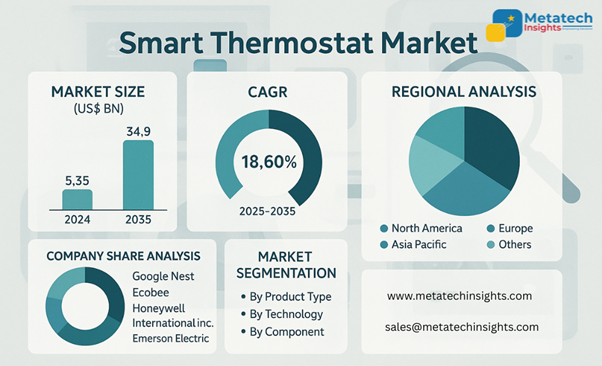Global Smart Thermostat Market to Hit USD 34.9 Billion by 2035 | CAGR 18.60%
09 Aug 2025 | Report ID: MI3242 | Industry: Novel Technology | Pages: 219 | Forecast Year: 2025-2035

Read more about this report- Global Smart Thermostat Market to Hit USD 34.9 Billion by 2035 | CAGR 18.60%
The Smart Thermostat Market is valued at USD 5.35 billion in 2024. The market is projected to reach USD 34.9 billion by 2035, growing at a robust CAGR of approximately 18.60% from 2025 to 2035.
One of the key opportunities of the smart thermostat market is the expanding interest in smart home technologies and the growing energy efficiency consciousness. Nonetheless, the issue of privacy in the collection of the data and online security is a major limiting factor. The market potential is in the combination of AI and IoT technologies to integrate the predictive and adaptive climate control functions.
The product types offered in the market under segmentation are the programmable and learning thermostats, technologies that are Wi-Fi-enabled and Zigbee-enabled devices, components made up of sensors, controllers, and connectivity modules, and applications that include residential, commercial, and industrial. These include learning thermostats, which have a significant market share, as they are able to learn the behavior of the user and automatically optimize energy use to increase demand due to greater convenience and cost savings.
On their part of the application, they are mostly used on the residential front with increasing consumer awareness and government incentives to gain energy-efficient homes. Such recent inventions are AI-controlled thermostats that combine with virtual assistants (such as Alexa and Google Assistant) to make the controls extra user-friendly and control the energy usage more efficiently. Initiatives like the Weatherization Assistance Program in the U.S. Department of Energy have increased the pace of access to and uptake of smart thermostats through subsidizing the cost to install them in low-income homes.
North America is the market leader geographically due to well-developed infrastructure, the higher penetration of smart homes, and favorable energy policies. Europe is hot on the heels with strict energy laws increasing demand. The most rapidly expanding market is the Asia-Pacific region, where there is rapid urbanization, rising smart city projects, and a growing middle class of consumers. There are new markets like Latin America, the Middle East, and Africa that have been favored by increased investments and awareness. It is worth noting that government-sponsored efforts to make cities smarter and enhanced incorporation of IoT into residential projects are marking China as a country that is becoming more active in the market.
The market is spearheaded by such key players as Nest (Google LLC), Ecobee Inc., Honeywell International Inc., Emerson Electric Co., and Schneider Electric SE. Such firms are growing the market by engaging in constant research and development, diversifying their product offerings, increasing the connectivity options, and building strategic networks to expand the uses of smart thermostats to other regions. The way they innovate and change current market dynamics is through their developments in AI integration, facile interface/experience, and energy analytics, which augment energy efficiency and customer outreach.
Maximize your value and knowledge with our 5 Reports-in-1 Bundle - over 40% off!
Our analysts are ready to help you immediately.
